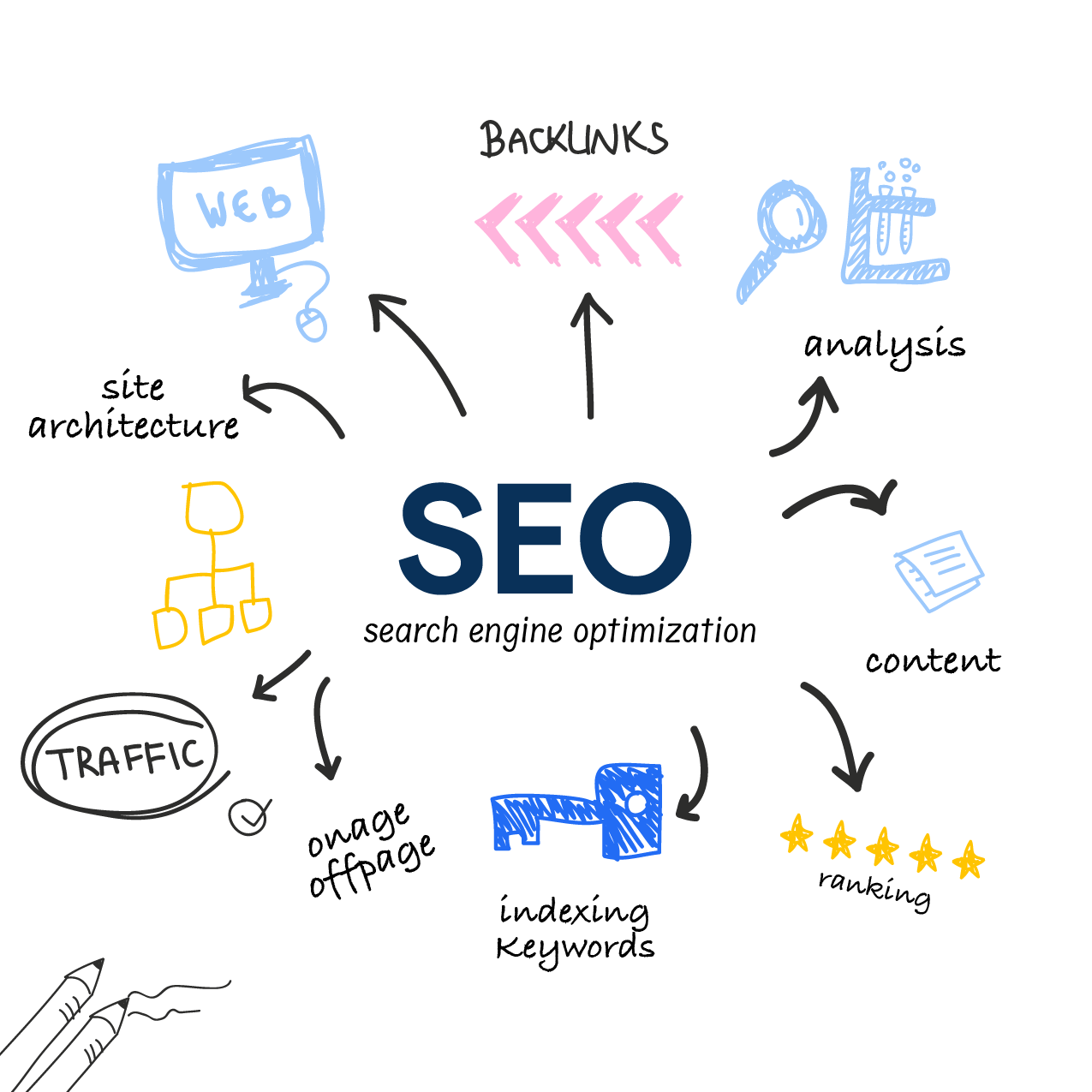Understanding SEO vs. SEM – Which is Right for Your Business?

When it comes to driving traffic to your website, it is important to understand SEO vs SEM. Search engine optimization (SEO) and search engine marketing (SEM) are two strategies that businesses commonly use. While both approaches aim to increase visibility on search engines, their objectives, strategies, and outcomes are quite different.
In this section, we’ll explore the differences between SEO and SEM, helping you understand which strategy is best suited for your business. We’ll examine the concepts of search engine optimization and search engine marketing, and discuss the advantages and disadvantages of both approaches.
Key Takeaways:
- SEO and SEM are both strategies for increasing visibility on search engines, but their objectives, strategies, and outcomes are different.
- SEO focuses on driving organic traffic to your website through keyword research, on-page optimization, and off-page optimization.
- SEM uses paid advertising to improve your website’s visibility on search engines and drive targeted traffic to your website.
- Choosing between SEO and SEM depends on various factors, including budget, timeline, competition, and business objectives.
- Both SEO and SEM can contribute to improved online visibility and growth for your business.
What is SEO?
If you’re looking to increase your website’s online visibility and attract more organic traffic, search engine optimization (SEO) is the way to go. By optimizing your website’s content and structure according to search engine best practices, you can improve your search engine rankings and drive more visitors to your site.
Keyword research is a crucial part of any SEO strategy. By identifying the keywords and phrases that people are searching for related to your business, you can tailor your content to match their intent and increase your chances of appearing in search results. Use a tool like Google Keyword Planner to identify keywords with high search volumes and low competition.
On-page optimization involves making changes to your website’s content and structure to boost its relevance for specific keywords. This includes optimizing your title tags, meta descriptions, headers, and content with relevant keywords and phrases.
Off-page optimization involves building high-quality backlinks to your website from other authoritative sites. This can improve your website’s credibility in the eyes of search engines and boost your rankings.
| SEO Elements | Description |
|---|---|
| Keyword Research | Identifying relevant keywords and phrases that people are searching for. |
| On-page Optimization | Tailoring your website’s content and structure to match specific keywords and improve relevance. |
| Off-page Optimization | Building high-quality backlinks from other authoritative sites to improve credibility. |
| Search Engine Rankings | The position of your website in search engine results pages (SERPs) for specific keywords. |
Implementing a well-executed SEO strategy can help increase your website’s online visibility, attract more organic traffic, and improve your search engine rankings. By focusing on keyword research, on-page optimization, and off-page optimization, you can create a website that’s optimized for search engines.
What is SEM?
If you’re looking to increase your website’s visibility and drive targeted traffic, search engine marketing (SEM) can be an effective approach. SEM involves utilizing paid advertising to appear at the top of search engine results pages. With SEM, you can get your business in front of the right audience at the right time, and only pay for clicks on your ads.
One of the core components of SEM is paid advertising. This can take the form of pay-per-click (PPC) ads, display ads, or social media advertising. By crafting compelling ad copy and targeting the right keywords, you can maximize the effectiveness of your advertising campaigns and drive more traffic to your website.
However, SEM is not just about advertising. It also involves optimizing your website’s content and structure to align with search engine algorithms and improve your organic search engine rankings. This includes conducting keyword research, optimizing on-page elements such as headings and meta descriptions, and building high-quality backlinks to your site.
Benefits of SEM:
| Benefits of SEM: | |
|---|---|
| Drives targeted traffic to your website | By targeting specific keywords and demographics, you can attract visitors who are more likely to convert into customers. |
| Increases brand visibility | Appearing at the top of search engine results pages can help your business gain more visibility and recognition among potential customers. |
| Provides measurable results | With SEM, you can track the performance of your advertising campaigns and adjust your strategy accordingly to maximize your return on investment. |
| Complements other digital marketing strategies | SEM can work alongside other approaches such as SEO and social media marketing to create a comprehensive digital marketing plan. |
Overall, SEM can be a valuable addition to your digital marketing strategy, helping you reach a wider audience and achieve your business goals.

Key Differences Between SEO and SEM
While SEO and SEM share the common goal of improving website visibility and generating traffic, they differ in several ways. Understanding the differences between these two approaches is crucial for deciding which one to use for your business. Some of the key differences between SEO and SEM are as follows:
- Organic vs. Paid: The primary difference between SEO and SEM is that SEO is focused on optimizing your website to rank higher in organic search results, while SEM involves paid advertising to achieve higher visibility on search engine results pages (SERPs).
- Cost: SEO generally requires a longer-term investment, as it takes time to build up the necessary optimization efforts to improve your rankings. In contrast, SEM involves a direct cost for each click on your paid ads.
- Keywords: SEO and SEM also differ in their approach to keywords. SEO focuses on optimizing your website for specific keywords that are relevant to your business, while SEM allows you to bid on keywords to display your paid ads in front of a specific audience.
- Strategy: SEO involves a more holistic approach to digital marketing, with a focus on optimizing your website’s structure, content, and backlinks. SEM requires a more targeted approach to advertising, with a focus on creating compelling ad copy and identifying the right target audience for your ads.
The table below summarizes the key differences between SEO and SEM:
| SEO | SEM |
|---|---|
| Focuses on organic traffic and search engine visibility | Uses paid advertising to achieve search engine visibility |
| Long-term investment | Direct cost for each click on ads |
| Optimizes for specific keywords | Bids on keywords to display ads in front of a specific audience |
| Holistic approach to digital marketing | Targeted approach to advertising |
By understanding these key differences between SEO and SEM, you can make an informed decision on which approach is best suited for your business needs.
Benefits of SEO
Implementing a well-planned SEO strategy can bring numerous benefits to your business. Below are some of the advantages of SEO:
- Organic traffic: SEO can increase your website’s organic traffic, meaning visitors who find your website through a search engine without seeing paid ads. This type of traffic is highly valuable as it is free and may result in more qualified leads.
- Website visibility: SEO can help your website appear higher in search engine results, making it more visible to potential customers. This increased visibility can lead to more website visits and conversions.
- Search engine rankings: A well-executed SEO strategy can help boost your website’s search engine rankings, making it easier for users to find your website when searching for relevant keywords.
SEO vs. SEM Advantages and Disadvantages
While SEO has numerous benefits, it’s essential to keep in mind that it may have some drawbacks when compared to SEM. Below are some pros and cons of using SEO:
| Advantages of SEO | Disadvantages of SEO |
|---|---|
|
|
Overall, SEO can be an effective long-term strategy for increasing website traffic and improving search engine rankings. However, it may take time and effort to see significant results, and ongoing optimization is necessary to maintain those results.
Benefits of SEM
Now that we’ve discussed the concept of SEM, let’s dive into its benefits for your business.
1. Increased website traffic: One of the primary advantages of SEM is that it can help drive targeted traffic to your website through paid advertising. By bidding on specific keywords related to your business, you can increase the likelihood of your ads appearing at the top of search engine results pages.
2. Improved brand visibility: SEM can also help improve your brand’s visibility among your target audience. By creating visually engaging ads with persuasive messaging, you can increase the likelihood of users clicking on your ads and visiting your website.
3. Greater control over your advertising: Unlike other forms of advertising, SEM provides you with greater control over your campaigns. You can set your own budget, create customized ad copy, and target specific demographics to ensure your ads reach the right people.
4. Quick results: Another benefit of SEM is that it can deliver quick results. Unlike SEO, which can take months to see results, SEM can help you see an immediate uptick in website traffic and conversions.
However, it’s important to note that there are some downsides to using SEM as well. Let’s examine the advantages and disadvantages of using SEO vs. SEM in the next section.

Factors to Consider When Choosing Between SEO and SEM
When deciding between SEO and SEM marketing, it’s important to consider several factors that can impact the effectiveness of your digital marketing strategy.
Budget: One of the key considerations is your budget. SEO is generally a more cost-effective strategy than SEM as it relies on organic traffic and can often produce long-term benefits with minimal ongoing expenses. SEM, on the other hand, requires a budget to create and run paid advertising campaigns.
Timeline: Another factor to consider is your timeline. SEO is a longer-term strategy that requires time and effort to see results. It can take several months before your website begins to rank higher in search engine results pages. SEM, on the other hand, can produce immediate results as paid advertising campaigns can be launched quickly.
Competition: Your competition in the industry is also an important factor to consider. If your competitors have a strong online presence and are already implementing SEO and SEM strategies, it may be more difficult for your business to stand out in search engine results pages. In this case, paid advertising through SEM may help to increase your visibility and reach a wider audience.
Business Objectives: Ultimately, your business objectives should guide your decision between SEO and SEM. Consider what you want to achieve with your digital marketing strategy. Are you looking to improve your website’s visibility in search engine results pages, drive more organic traffic, or increase sales and leads? Understanding your goals can help you determine which strategy is better suited for your business.
By taking these factors into account, you can make an informed decision on whether SEO or SEM is the more effective approach for your business needs.
Choosing the Right Strategy for Your Business
Choosing between SEO and SEM can be a difficult decision for businesses. There are several factors to consider to make the right choice. Here is a framework that can guide you:
- Evaluate your business goals: Consider what your business aims to achieve through online marketing. Are you looking for immediate results or long-term growth?
- Analyze your resources: Evaluate your budget, expertise, and time before selecting a strategy. SEM usually requires a larger budget, while SEO demands more time and knowledge.
- Identify your competition: Analyze how your competitors are using SEO and SEM. This information can guide you in selecting the right approach.
- Understand your target audience: Determine where your target audience is most likely to find your business. This information can help you decide which strategy can better reach your audience.
Once you have assessed these factors, you can decide which approach is better suited for your business. Remember, there’s no one-size-fits-all solution. Both SEO and SEM can be effective in their own way. Some businesses even use both for a comprehensive digital marketing strategy.
It’s important to note that choosing between SEO and SEM is not always a binary decision. In many cases, it’s possible to combine the two approaches for maximum impact. This is known as SEO and SEM marketing. It involves leveraging the strengths of both strategies to achieve desired outcomes. For instance, you can use SEO for long-term growth and SEM for immediate results.
Ultimately, the decision between SEO and SEM depends on your business’s unique needs, goals, and resources. Take time to evaluate your options and select the approach that aligns with your objectives.
Implementing an Effective SEO Strategy
To reap the benefits of SEO, you need to implement an effective strategy that maximizes your chances of ranking high in search engine results. In this section, we will provide practical tips and advice to help you optimize your website for search engines and drive organic traffic to your site.
Step 1: Conduct Keyword Research
Keyword research is the foundation of any successful SEO strategy. By identifying the keywords and phrases that your target audience is searching for, you can tailor your content to meet their needs and increase your chances of ranking high in search results.
When conducting keyword research, focus on long-tail keywords that are specific to your business and industry. Use tools like Google Keyword Planner or Ahrefs to identify high-volume, low-competition keywords that you can target in your content.
Step 2: Optimize Your On-Page Elements
The on-page elements of your website play a critical role in SEO. To optimize your on-page elements:
- Include your target keywords in your website’s title tags, meta descriptions, headers, and content.
- Ensure your website’s content is high-quality, relevant to your audience, and easy to navigate.
- Optimize your images by using descriptive file names and alt tags.
Step 3: Improve Your Off-Page Elements
Off-page elements like backlinks and social media signals can also impact your website’s SEO. To improve your off-page elements:
- Create high-quality content that other websites will want to link to.
- Build relationships with other websites in your industry and collaborate on guest posts or link exchanges.
- Use social media to share and promote your content and encourage engagement from your audience.
Step 4: Monitor and Analyze Your Performance
Regularly monitoring and analyzing your SEO performance is crucial for improving your strategy over time. Use tools like Google Analytics and SEMrush to track your website’s organic traffic, search engine rankings, and other relevant metrics.
Maximizing Results with SEM
Search engine marketing (SEM) involves paid advertising to promote your website on search engines. Through SEM, you can reach a wider audience and drive targeted traffic to your website. However, to maximize the results of your SEM efforts, you need to implement effective strategies.
Craft Compelling Ad Copy
The ad copy is the first thing your potential audience sees when they search for keywords relevant to your business. Therefore, it’s essential to craft compelling ad copy that captures their attention and entices them to click through to your website. Keep in mind that your ad copy should be concise, informative, and tailored to your target audience. Highlight your unique selling proposition and include a clear call to action that encourages users to take the desired action, such as making a purchase or filling out a form.
Target the Right Keywords
Keywords are the foundation of your SEM campaign. It’s crucial to target the right keywords that align with your business goals and match your website’s content. Conduct thorough keyword research to identify relevant keywords with high search volume and low competition. Use these keywords in your ad copy and landing pages to improve relevancy and boost your Quality Score, which can increase the effectiveness and lower the cost of your SEM campaign.
Optimize Your Paid Advertising Campaigns
Optimizing your SEM campaigns requires ongoing monitoring and testing. Continuously track your ad performance, such as click-through rate (CTR), conversion rate, and cost per click (CPC). Use A/B testing to experiment with different ad variations and landing pages to determine the most effective combinations. Regularly adjust your bids, ad targeting, and ad scheduling based on your campaign data to maximize your SEM results.
Tracking and Analyzing Performance
Measuring the success of your SEO and SEM efforts is crucial to improving your online presence and achieving your business goals. By tracking and analyzing key metrics, you can identify what’s working, what’s not, and make data-driven decisions to optimize your campaigns.
Organic traffic is a key metric for measuring the effectiveness of your SEO strategy. Tools like Google Analytics can help you track organic traffic to your website, where it’s coming from, and how users are engaging with your content. By monitoring organic traffic, you can identify which keywords are driving the most traffic to your site and adjust your strategy accordingly.
Paid advertising is a critical component of your SEM strategy, and it’s essential to track the performance of your ad campaigns. Use tools like Google Ads to monitor metrics such as click-through rates (CTR), cost per click (CPC), and conversion rates. By analyzing these metrics, you can refine your targeting, ad copy, and bidding strategies to improve your results.
Search Engine Rankings
Your search engine rankings are a reflection of the effectiveness of both your SEO and SEM strategies. Tools like SEMrush can help you track your search engine rankings for specific keywords and compare your performance against your competitors. Analyzing your rankings can provide insights into how your content and website are performing and help you identify opportunities for improvement.
Putting it All Together
Tracking and analyzing the performance of your SEO and SEM campaigns requires a focused approach and a commitment to evaluating your data regularly. By monitoring metrics such as organic traffic, paid advertising performance, and search engine rankings, you can gain a deeper understanding of your online presence and improve your results over time.

Evolution of SEO and SEM
Understanding the evolution of SEO and SEM over time is crucial to staying ahead of the competition. Search engines have constantly updated their algorithms, making it necessary for businesses to adapt their strategies to remain visible to their target audience.
The Rise of Search Engine Optimization (SEO)
In the early days of the internet, search engines were still in their infancy. However, as more and more websites emerged, businesses realized the importance of being found online. This led to the birth of SEO, which focused on improving website visibility through organic search results.
The first search engine, Archie, was launched in 1990. However, it wasn’t until the mid-1990s that search engines began to resemble what we know today. One of the first popular search engines was Yahoo!, which relied on human editors to categorize websites for search results.
In 1996, search engines began to use algorithms to rank websites. This led to the rise of keyword stuffing, a technique used to manipulate search engine rankings by repeating specific keywords throughout a website’s content. However, search engines quickly caught on, and the practice was penalized.
Over time, search engines continued to refine their algorithms. They began to focus more on the user experience and relevance of website content, and less on the number of keywords used. This led to the birth of on-page optimization, off-page optimization, and other tactics used to improve website rankings.
The Emergence of Search Engine Marketing (SEM)
While SEO focused on improving organic search results, SEM emerged as a way to drive targeted traffic to websites through paid advertising. The first paid search engine advertisement was launched by Goto.com (later renamed Overture) in 1998.
Google launched Google AdWords in 2000, which allowed businesses to bid on keywords to display ads alongside search results. SEM quickly became a popular way for businesses to reach their target audience and drive traffic to their websites.
Today, SEM has evolved to include not only paid search engine advertising but also social media advertising, display advertising, and other forms of online advertising.
The Future of SEO and SEM
SEO and SEM will continue to evolve as search engines and technology advance. As artificial intelligence and voice search become more prevalent, businesses will need to adapt their strategies to remain visible to their target audience.
Key Takeaways
- Search engines have constantly updated their algorithms, making it necessary for businesses to adapt their strategies to remain visible to their target audience.
- The rise of SEO in the mid-1990s focused on improving website visibility through organic search results.
- SEM emerged as a way to drive targeted traffic to websites through paid advertising.
- Today, SEO and SEM continue to evolve, and businesses must adapt their strategies to remain competitive.
Common SEO and SEM Mistakes to Avoid
When it comes to SEO and SEM, there are common mistakes that businesses make that can harm their overall online presence. By avoiding these mistakes, you can optimize your strategies and achieve better results.
Keyword Stuffing
One of the most common SEO mistakes is keyword stuffing, which is the overuse of keywords on a webpage. This practice used to work in the past, but it can now result in penalties from search engines and harm your rankings. Instead, focus on creating content that is high-quality and relevant to your audience while naturally incorporating keywords.
Ignoring Analytics
SEM campaigns require constant monitoring and analysis to ensure they are performing well and achieving their goals. Failing to pay attention to analytics or not using them at all can result in wasted ad spend and missed opportunities for improvement.
Not Optimizing for Mobile
With more people accessing the internet through smartphones and tablets, it’s crucial to ensure your website is optimized for mobile. Neglecting this can result in a poor user experience and lower search engine rankings. Make sure your site is mobile-friendly and easy to navigate.
Choosing the Wrong Keywords
Another common mistake is selecting the wrong keywords for your SEO or SEM campaigns. If your keywords are too broad, you may attract irrelevant traffic to your site. On the other hand, if your keywords are too specific, you may not attract enough traffic. Conduct thorough keyword research, analyze the competition, and choose keywords that align with your business goals.
Ignoring Local SEO
For businesses with a physical location, ignoring local SEO can result in missed opportunities to attract nearby customers. Make sure your website and online listings are optimized for local search, including accurate business information and location-specific keywords.
Focusing Solely on Rankings
While high search engine rankings are important, they are not the only measure of success for SEO and SEM. It’s crucial to also focus on driving traffic, engagement, and conversions on your website. Pay attention to the overall user experience and ensure your strategies align with your business goals.
Case Studies and Success Stories
Real-life examples can help you understand the potential impact of SEO and SEM on your business. Here are a few success stories that showcase the effectiveness of these strategies:
| Company | Challenge | Solution | Results |
|---|---|---|---|
| XYZ Corporation | Low website traffic and poor visibility on search engines | Implemented an SEO strategy that included keyword research, on-page optimization, and link building | Organic traffic increased by 250% within 6 months, resulting in higher search engine rankings and increased sales |
| ABC Enterprises | Low conversions and high bounce rates on website | Combined an SEM strategy with landing page optimization and A/B testing | Increased conversion rate by 75% and decreased bounce rate by 50%, resulting in higher ROI |
| 123 Inc. | Low brand awareness and limited online presence | Launched an integrated SEO and SEM campaign, including paid advertising and social media marketing | Increased website traffic by 200% and boosted brand visibility, resulting in greater customer engagement and sales |
These examples demonstrate how SEO and SEM can be adapted to meet the unique challenges and goals of different businesses. By leveraging the power of organic traffic and paid advertising, you can improve your website’s visibility, drive targeted traffic, and achieve higher conversions.
Conclusion
As you have learned, SEO and SEM are two distinct strategies for increasing your website’s online visibility and traffic. SEO focuses on optimizing your website so that it ranks well in organic search results, while SEM incorporates paid advertising to boost your website’s visibility on search engines.
Both SEO and SEM have their unique advantages and disadvantages, and you need to carefully consider your business’s goals, budget, and target audience to determine which strategy is the best fit for your needs. However, regardless of which approach you choose, search engine optimization and search engine marketing can help you drive targeted traffic to your website and increase your online visibility.
By applying the tips and insights provided in this article and staying up-to-date with the ever-evolving landscape of SEO and SEM, you can position your business for success and drive growth in the online space.
FAQ
Q: What is the difference between SEO and SEM?
A: SEO (search engine optimization) focuses on improving your website’s visibility in organic search results, while SEM (search engine marketing) involves paid advertising to increase your website’s visibility on search engines.
Q: What is SEO?
A: SEO stands for search engine optimization. It is the process of optimizing your website to improve its visibility in organic search results and drive more organic traffic to your site.
Q: What is SEM?
A: SEM stands for search engine marketing. It involves utilizing paid advertising to increase a website’s visibility on search engines and attract targeted traffic.
Q: What are the key differences between SEO and SEM?
A: SEO focuses on organic search results and involves optimizing your website to improve its visibility. SEM, on the other hand, requires paid advertising to increase visibility and reach a wider audience.
Q: What are the benefits of SEO?
A: SEO can drive organic traffic to your website, improve your website’s visibility in search engine results, and boost your search engine rankings.
Q: What are the benefits of SEM?
A: SEM can help you reach a wider audience, increase brand visibility, and drive targeted traffic to your website through paid advertising.
Q: What factors should I consider when choosing between SEO and SEM?
A: Factors to consider include your budget, timeline, competition, and business objectives. Evaluating these aspects can help you determine which strategy aligns better with your specific needs.
Q: How can I choose the right strategy for my business?
A: To choose the right strategy, evaluate your goals, resources, and target audience. This assessment will help determine whether SEO or SEM is the more effective approach for your business.
Q: How can I implement an effective SEO strategy?
A: Implementing an effective SEO strategy involves conducting keyword research, optimizing your website’s on-page and off-page elements, and enhancing your website’s visibility in search engine results.
Q: How can I maximize results with SEM?
A: To maximize results with SEM, focus on crafting compelling ad copy, targeting the right keywords, and optimizing your paid advertising campaigns for better performance.
Q: Why is tracking and analyzing performance important for SEO and SEM?
A: Tracking and analyzing performance helps you measure the success of your SEO and SEM efforts. It allows you to monitor organic traffic, evaluate the impact of paid advertising, and make data-driven decisions to optimize your campaigns.
Q: How have SEO and SEM evolved over time?
A: SEO and SEM have evolved in response to changes in search engine algorithms, user behavior, and technological advancements. Adapting your approach to these changes is crucial to stay ahead of the competition.
Q: What are common SEO and SEM mistakes to avoid?
A: Common mistakes include neglecting proper keyword research, focusing solely on paid advertising, and failing to optimize on-page and off-page elements. Avoiding these mistakes can improve the effectiveness of your SEO and SEM campaigns.
Q: Can you provide case studies and success stories for SEO and SEM?
A: Yes, we showcase real-life case studies and success stories that demonstrate the effectiveness of SEO and SEM strategies. Analyzing these examples can provide inspiration and insights for your own campaigns.





